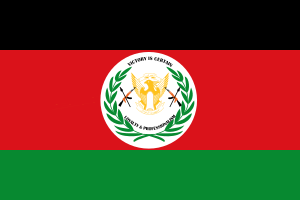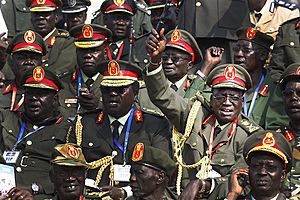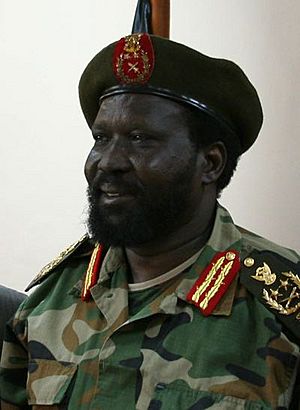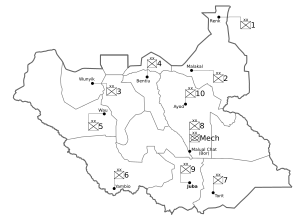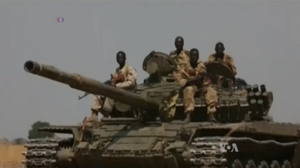South Sudan People's Defence Forces facts for kids
The South Sudan People's Defence Forces (SSPDF) is the official army of South Sudan. It used to be called the Sudan People's Liberation Army (SPLA). The SPLA started in 1983 as a group fighting against the government of Sudan. It played a big part in the Second Sudanese Civil War, led by John Garang.
After Garang passed away in 2005, Salva Kiir became the new leader of the SPLA. In 2010, the SPLA was organized into large groups called divisions, each with 10,000 to 14,000 soldiers.
In 2005, a special agreement called the Comprehensive Peace Agreement was signed. This agreement brought together the SPLA and another large armed group called the South Sudan Defence Forces (SSDF). They joined under the SPLA name.
When South Sudan became an independent country in 2011, the SPLA became its official national army. In 2017, the army's name changed to South Sudan Defence Forces (SSDF), and then again in September 2018 to the South Sudan People's Defence Forces (SSPDF). As of 2018, the army had about 185,000 soldiers. It also has a small South Sudan Air Force. By 2019, the SSPDF included the Ground Force, Air Force, Air Defence Forces, and a special Presidential Guard.
Quick facts for kids South Sudan People's Defence Forces |
|
|---|---|
| Flag of the SPLA (2011 to present).svg Flag of the South Sudan People's Defence Forces |
|
| Established | 1983 |
| Current form | 2018 |
| Parts | Ground Force Air Force and Air Defence Riverine/Navy |
| Headquarters | Bilpham, Central Equatoria Malual-Chaat, Bor Wunyiek, Northern Bahr el Ghazal Mapel, Western Bahr el Ghazal |
| Leadership | |
| Commander-in-chief | Salva Kiir Mayardit |
| Minister of Defence and Veterans Affairs | Chol Thon Balok |
| Chief of Defense Forces | General Santino Deng Wol (since 11 April 2021) |
| Serving soldiers | |
| Military age | 18 |
| Active employees/soldiers | 185,000 |
| Expenditures | |
| Budget | £10,240,750,031 SSP ($78,615,712) [2016/17] |
| Percent of GDP | 0.86% (2015 est.) |
| Industry | |
| Suppliers from inland | Military Industry Corporation |
| See also | |
| History | Military history of South Sudan
(SPLM)
|
| Ranks | Military ranks of South Sudan |
Contents
History of the South Sudan People's Defence Forces
How the SPLA Started in 1983
On May 16, 1983, a group of soldiers in Bor rebelled against the Sudanese army. This event led to other similar rebellions in the southern part of Sudan. These actions eventually led to the creation of the SPLA.
The Sudan People's Liberation Army was officially formed in 1983. Its first leader was Commander-in-Chief John Garang de Mabior. Many of the rebelling soldiers moved to Ethiopia, where the Ethiopian government supported the new SPLA.
The SPLA fought for a united and fair Sudanese state. John Garang believed that the struggles of people in the South were similar to those of other groups in the North, like the Nuba people. The SPLA was against the introduction of strict religious laws (sharia law) in September 1983.
Fighting in the 1980s
In 1984, the first full SPLA soldier group finished its training in a village called Bilpam. This place became very important to the SPLA. Other training camps were set up later.
In the mid-1980s, the SPLA's fighting stopped some development projects by the Sudanese government, like oil fields.
The SPLA started its first major move into the Equatoria region in 1985-1986. During this time, they faced other armed groups that supported the government. The SPLA also caused many Ugandan refugees to return to Uganda.
The SPLA had a difficult relationship with another group called Anyanya II. Anyanya II tried to stop the SPLA from growing between 1984 and 1987. However, some Anyanya II leaders later joined the SPLA.
Another group the SPLA fought was the Murahaleen militias in northern Bahr el-Ghazal. This fighting began in 1987. By 1988, the SPLA controlled most of northern Bahr el-Ghazal.
In 1987, the SPLA captured a town called Kurmak. This town was important because a nearby dam provided much of the capital city's electricity.
Political Discussions and Changes
The SPLA did not take part in the 1986 elections. Because of this, elections could not be held in half of the southern Sudan areas.
In 1988, the SPLA formed an alliance with another political party, the DUP. They agreed that strict laws should be removed. However, peace talks stopped after the SPLA shot down a civilian airplane, killing 60 people.
When a new government took power in 1989, all peace talks ended. The SPLA then launched a big attack between 1989 and 1991. They captured many towns across southern Sudan. By mid-1991, the SPLA controlled most parts of southern Sudan, except for a few major towns. The SPLA's actions during this time were more organized than before.
Setbacks and Splits in 1991
A big problem for the SPLA happened in May 1991 when the government in Ethiopia changed. Ethiopia had supported the SPLA with weapons and training for 18 years. After this change, many refugees and SPLA members had to return to Sudan.
Around this time, a disagreement started within the SPLA. Some leaders, like Lam Akol and Riek Machar, began to question John Garang's leadership. This disagreement became public on August 28, 1991, in what was called the Nasir Declaration. These leaders wanted the SPLA to be more democratic and for South Sudan to become an independent country.
The SPLA then split into two groups: the mainstream SPLA led by Garang and the 'SPLA-Nasir'. These two groups began fighting each other, sometimes harming civilians.
Battles in 1992
In 1992, the Sudanese government launched a major attack against the SPLA. The SPLA was weaker because of its internal split. The SPLA lost control of several towns, including Torit, where its headquarters were.
The SPLA tried to capture Juba twice in June–July 1992. After these attacks, the Sudanese government forces punished civilians harshly.
Comprehensive Peace Agreement in 2005
Before the Comprehensive Peace Agreement (CPA) was signed in 2005, some groups estimated that between 2,500 and 5,000 children were serving in the SPLA.
After the CPA was signed, the SPLA started to reorganize itself. The United States helped by providing money for this process. In 2005, John Garang changed the top leadership of the SPLA.
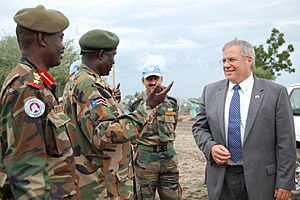
The SPLA was organized into six main divisions and four smaller independent brigades. These groups were spread across different states in South Sudan.
A very important agreement was the Juba Declaration, signed by Salva Kiir and General Paulino Matiep in January 2006. Matiep led the South Sudan Defence Forces (SSDF), which was a large armed group not controlled by the SPLA. Paulino Matiep was given a high position in the SPLA, and about 50,000 SSDF members joined the SPLA. This brought together the two largest armed groups in the region. By 2011, when South Sudan became independent, the SPLA had many generals.
Ministry of Defence and Changes
In 2007, the SPLA created a Ministry of Defence. General Dominic Dim Deng became the first Minister for SPLA Affairs. He passed away in a plane crash in 2008.
In 2009, James Hoth Mai became the Chief of General Staff, the top military position. In 2010, U.S. officials noted that the SPLA needed to be reorganized because it had too many general officers.
The 2005 peace agreement said that SPLA soldiers in northern Sudan should move south. This happened in 2008. However, some fighters remained north of the border. In 2011, fighting started again in some northern areas, and these former SPLA fighters formed a new group called the Sudan People's Liberation Movement-North (SPLA-N).
The SPLA's main headquarters near Juba was called 'Bilpam'. It was expanded after 2008.
South Sudanese Civil War
On December 15, 2013, fighting broke out in Juba among different parts of the army. The government said it was an attempt to overthrow the president. President Kiir announced that the attempt was stopped, but fighting continued.
The Sudan People's Liberation Movement (SPLM) then split into two main groups:
- The Sudan People's Liberation Movement (In Government) was led by President Kiir. This was the group that signed the 2005 peace agreement.
- The Sudan People's Liberation Movement (In Opposition) was formed in 2013 and led by former Vice President Riek Machar. This group became the main opponent to President Kiir's government in the civil war.
During the war, the SPLA became mostly made up of soldiers from the Dinka ethnic group.
Renaming to SSPDF (2017–2018)
On May 16, 2017, President Kiir announced that the army's name would change to the South Sudan Defence Forces (SSDF).
In August 2017, Kiir announced another name change to the South Sudan People's Defence Forces (SSPDF). He said this was to show the will of the people and to make the army more professional. This change also helped to show that the army was now focused on defending the country, not just on the past fight for freedom.
The army was officially renamed the South Sudan People's Defence Forces in September 2018. This happened just before new security plans were put into action, which included bringing the national army back together. President Kiir remained the Commander-in-Chief.
As of 2018, the army had about 185,000 soldiers and a small air force.
A peace agreement in September 2018 said that all armed groups in South Sudan should gather at certain places. Fighters could then be disarmed or join the unified military and police forces. This process was still ongoing in 2020.
The SSPDF in 2019
In 2019, the SSPDF included the Ground Force, Air Force, Air Defense Forces, and the Presidential Guard.
In October 2019, more than 40 SSPDF members received training from the United Nations Mission in South Sudan (UNMISS). UNMISS has been in South Sudan since 2011 to help keep peace and security.
How the SSPDF is Organized and What Equipment It Uses
The SSPDF is led by the Chief of Defence Forces. James Hoth Mai was the Chief of General Staff until 2014, when Paul Malong Awan took over.
After the army was restructured as the SSPDF, James Ajongo Mawut became the Chief of Defence Force(s) in May 2017. After he passed away in April 2018, General Gabriel Jok Riak took his place.
In May 2020, President Kiir appointed General Johnson Juma Okot as Chief of Defence Forces. Then, on April 11, 2021, Santino Deng Wol became the new Chief of Defense Forces.
SPLA Structure and Equipment Details
The Chief of General Staff oversees five main departments:
- Administration
- Operations
- Logistics
- Political and Moral Orientation
- Training and Research
The SPLA had nine divisions and a small air force.
- 1st Division : Located in Renk, Upper Nile State.
- 2nd Division : Located in Juba, Central Equatoria State.
- 3rd Division : Located in Akuem, Northern Bahr el Ghazal.
- 4th Division : Located in Mapel, Western Bahr el Ghazal.
- 5th Division : Located in Wau, Western Bahr el Ghazal State.
- 6th Division : Located in Maridi, Western Equatoria.
- 7th Division : Located in Owachi, Upper Nile State.
- 8th Division : Located in Bor, South Sudan. This division was formed from groups that led the first rebellion in 1983.
- Commando: This special brigade was formed after South Sudan's independence. It was known for being well-trained.
- Mechanized Division : Located in Mapel, Western Bahr el Ghazal State.
- Special Forces brigade with four battalions.
- The Sudan People's Air Force : Located in Juba, Central Equatoria State.
A 2015 security agreement stated that military forces in Juba, Bor, and Malakal should move to bases at least 25 kilometers outside these cities. The Presidential Guard and SPLA's General Headquarters were exceptions.
Military Equipment
As of 2013, the SPLA's ground forces used:
- 110 T-72 tanks
- A few T-55 tanks
- 12 2S1 Gvozdika artillery vehicles
- 12 2S3 Akatsiya artillery vehicles
- 15 BM-21 Grad rocket launchers
- Mamba APC armored vehicles
- More than 30 82mm mortars
As of 2013, the South Sudan Air Force used:
Defence Spending
Here's how much South Sudan spent on its military from 2011 to 2013:
| Year | South Sudanese pounds | US dollar equivalent |
|---|---|---|
| 2011 | 1.6bn | 533m |
| 2012 | 2.42bn | 537m |
| 2013 | 2.52bn |
See also
 In Spanish: Fuerzas Armadas de Sudán del Sur para niños
In Spanish: Fuerzas Armadas de Sudán del Sur para niños
- Democratic Change (South Sudan), a political party
- Sudan Liberation Movement/Army, a rebel group in Sudan
- Sudan People's Liberation Movement (SPLM), a political party in South Sudan
- Sudan People's Liberation Movement-in-Opposition, a political party that split from the SPLM in 2013
- Sudan People's Liberation Movement-North, a political party and armed group in Sudan


